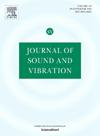Theoretical analysis and one-step balancing solutions of four types of density harmonic defects in hemispherical resonators
IF 4.3
2区 工程技术
Q1 ACOUSTICS
引用次数: 0
Abstract
The performance of hemispherical resonators is highly sensitive to circumferential density harmonic defects. Due to a limited understanding of the imbalances induced by the first three harmonic defects and their corresponding balancing theory, typical resonators operating in the second bending mode often balance only the 4th harmonic defect iteratively. This paper studies unbalanced effects caused by density harmonic defects in the n-th bending mode using elastic thin shell theory. It demonstrates that imbalances are related solely to the (n − 1)-th, n-th, (n + 1)-th, and 2n-th density harmonic defects. Furthermore, identification and balancing equations for the four types of harmonic defects are presented. The existence of one-step balancing solutions is examined, and the one-step balancing solutions are investigated. Fixed balancing orientation can linearize the balancing equations, and balancing the four types of harmonic defects requires a minimum of eight positions. Using the commonly employed hemispherical resonator in the second bending mode as an example, this study offers a complete solution with “arbitrary constant” properties. Numerical calculations indicate that the proposed complete solution achieves an accuracy of 10 ng, and uncertainties in the magnitude of corrections do not lead to divergence. The new theory and method eliminate coupling issues inherent in traditional n-symmetry removal algorithms, reduce the number of balancing iterations, and facilitate quick, efficient, and accurate balancing of high-precision hemispherical resonators.
半球形谐振器中四种密度谐波缺陷的理论分析及一步平衡解
半球形谐振器的性能对周向密度谐波缺陷非常敏感。由于对前三次谐波缺陷引起的不平衡及其相应的平衡理论的理解有限,典型的工作在第二弯曲模式下的谐振器通常只迭代地平衡第四次谐波缺陷。本文利用弹性薄壳理论研究了n阶弯曲模态中密度调和缺陷引起的不平衡效应。结果表明,不平衡仅与(n−1)次、n次、(n + 1)次和2n次密度谐波缺陷有关。在此基础上,给出了四种谐波缺陷的识别和平衡方程。检验了一步平衡解的存在性,并对一步平衡解进行了研究。固定的平衡方向可以使平衡方程线性化,平衡四种谐波缺陷最少需要8个位置。本文以二阶弯曲模式下常用的半球形谐振器为例,给出了具有“任意常数”性质的完整解。数值计算表明,所提出的完整解达到了10 ng的精度,并且修正幅度的不确定性不会导致发散。新的理论和方法消除了传统n-对称去除算法固有的耦合问题,减少了平衡迭代次数,促进了高精度半球形谐振器的快速、高效和准确平衡。
本文章由计算机程序翻译,如有差异,请以英文原文为准。
求助全文
约1分钟内获得全文
求助全文
来源期刊

Journal of Sound and Vibration
工程技术-工程:机械
CiteScore
9.10
自引率
10.60%
发文量
551
审稿时长
69 days
期刊介绍:
The Journal of Sound and Vibration (JSV) is an independent journal devoted to the prompt publication of original papers, both theoretical and experimental, that provide new information on any aspect of sound or vibration. There is an emphasis on fundamental work that has potential for practical application.
JSV was founded and operates on the premise that the subject of sound and vibration requires a journal that publishes papers of a high technical standard across the various subdisciplines, thus facilitating awareness of techniques and discoveries in one area that may be applicable in others.
 求助内容:
求助内容: 应助结果提醒方式:
应助结果提醒方式:


